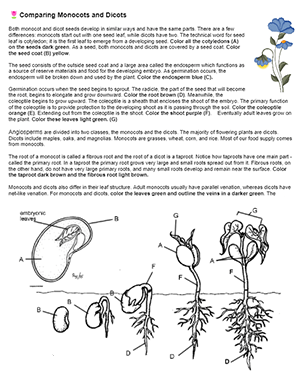
I made this simple worksheet on monocots and dicots for students to learn the differences between plant phyla.
Plant biology is usually the last unit of the year, and students really have trouble focusing. Coloring is a nice way to relax and be creative. I have several coloring worksheets for my biology and anatomy classes.
The main differences between monocots and dicots:
- Monocots have one cotyledon (vein) in the embryo, while dicots have two
- Monocot leaves have parallel venation, while dicot leaves have reticulate or net venation
- Monocot leaves have stomata on both surfaces, while some dicots have stomata on only one surface
- Monocots tend to have fibrous roots that web off in many directions, while dicots have a taproot system
- Monocots have flower parts in multiples of three, while dicots have flower parts in multiples of four or five
In addition to this coloring, we do seed germination experiments using plastic bags and paper towels. Students can then compare how a bean grows (dicot) to how a corn plant (monocot) grows.
The worksheet describes how seeds contain the endosperm as a nutrient source. Students then learn that each type of seed grows in a different way. Dicots have two cotyledons and monocots only have one. Root structure and leaf venation are also different in the two types of plants. Finally, students compare the flower structure of the two plants. Since their seedlings probably won’t grow to that stage, students can compare the leaves of the resident classroom plants.
I usually keep spider plants, zebrina, and aloe plants for students to make comparisons, but if it’s a nice day, we can go outside and look at plants around the campus. The zebrina plant (commonly called “wandering jew” is also useful to keep around because students can view stomata under the microscope.

